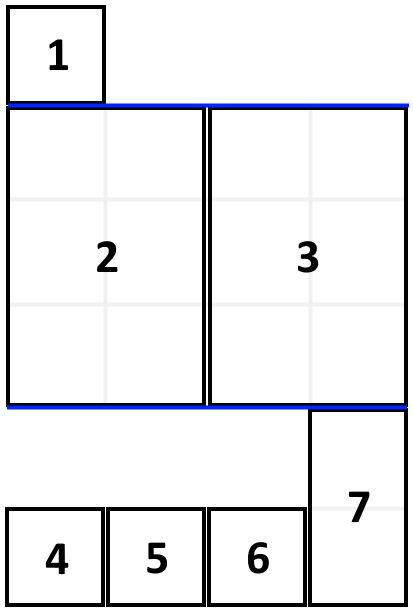- {x}
- Game Play Analysis V
- Unpopular Books
- Two Sum Less Than K
- Find K-Length Substrings With No Repeated Characters
- The Earliest Moment When Everyone Become Friends
- Path With Maximum Minimum Value
- Distribute Candies to People
- Path In Zigzag Labelled Binary Tree
- Filling Bookcase Shelves
- Parsing A Boolean Expression
- New Users Daily Count
- Defanging an IP Address
- Corporate Flight Bookings
- Delete Nodes And Return Forest
- Maximum Nesting Depth of Two Valid Parentheses Strings
- Highest Grade For Each Student
- Reported Posts
- Read More...

Filling Bookcase Shelves
You are given an array books where books[i] = [thicknessi, heighti] indicates the thickness and height of the ith book. You are also given an integer shelfWidth.
We want to place these books in order onto bookcase shelves that have a total width shelfWidth.
We choose some of the books to place on this shelf such that the sum of their thickness is less than or equal to shelfWidth, then build another level of the shelf of the bookcase so that the total height of the bookcase has increased by the maximum height of the books we just put down. We repeat this process until there are no more books to place.
Note that at each step of the above process, the order of the books we place is the same order as the given sequence of books.
- For example, if we have an ordered list of
5books, we might place the first and second book onto the first shelf, the third book on the second shelf, and the fourth and fifth book on the last shelf.
Return the minimum possible height that the total bookshelf can be after placing shelves in this manner.
Example 1:

Input: books = [[1,1],[2,3],[2,3],[1,1],[1,1],[1,1],[1,2]], shelfWidth = 4 Output: 6 Explanation: The sum of the heights of the 3 shelves is 1 + 3 + 2 = 6. Notice that book number 2 does not have to be on the first shelf.
Example 2:
Input: books = [[1,3],[2,4],[3,2]], shelfWidth = 6 Output: 4
Constraints:
1 <= books.length <= 10001 <= thicknessi <= shelfWidth <= 10001 <= heighti <= 1000
Solution Explanation: Filling Bookcase Shelves
This problem asks to find the minimum height of a bookshelf given a list of books and the shelf width. We can solve this using dynamic programming.
Approach: Dynamic Programming
The core idea is to build a DP array where dp[i] represents the minimum height needed to shelve the first i books.
-
Base Case:
dp[0] = 0. No books, no height. -
Iteration: For each book
i, we consider two possibilities:-
New Shelf: Place book
ion a new shelf. The height increases by the height of booki. So,dp[i] = dp[i-1] + height[i]. -
Existing Shelf: Try to add book
ito the existing shelf with some previous books. We iterate backward fromi-1to find the furthest bookjthat can fit on the same shelf without exceedingshelfWidth. The height of this shelf will be the maximum height of books fromjtoi. So,dp[i] = dp[j-1] + max_height.
-
-
Minimum: For each
i, we choose the minimum between placing bookion a new shelf and adding it to an existing shelf.
Time and Space Complexity
-
Time Complexity: O(n^2), where n is the number of books. The nested loop iterates through all possible combinations of placing books on shelves.
-
Space Complexity: O(n), due to the DP array
dp.
Code Implementation (Python)
def minHeightShelves(books, shelfWidth):
n = len(books)
dp = [float('inf')] * (n + 1) # Initialize with infinity
dp[0] = 0
for i in range(1, n + 1):
width = 0
height = 0
# Iterate backward to check if current book can be added to existing shelf
for j in range(i - 1, -1, -1):
width += books[j][0]
height = max(height, books[j][1])
if width <= shelfWidth:
dp[i] = min(dp[i], dp[j] + height) #Update dp[i] if adding to an existing shelf gives a lower height
else:
break #If width exceeds shelfWidth then break the loop
dp[i] = min(dp[i], dp[i - 1] + books[i - 1][1]) #Always have the option of putting the book on a new shelf
return dp[n]